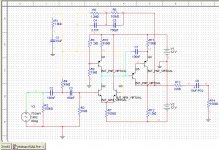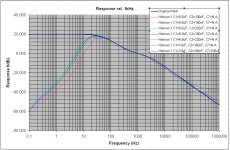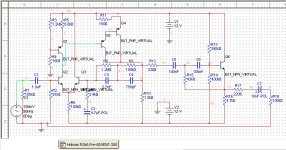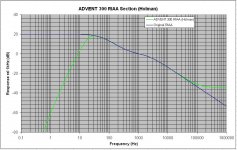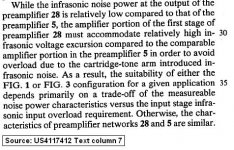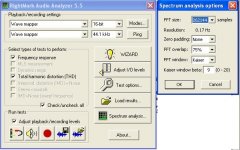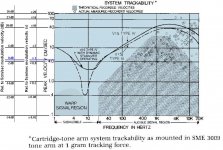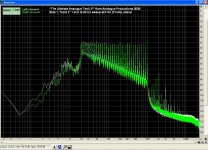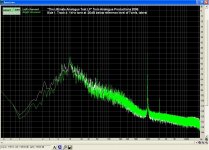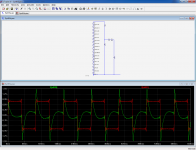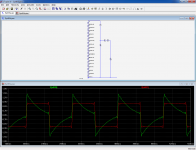They were wise.Hard work, working for Apple. My associates declined a similar position.
Let's talk about the practical use of subsonic filters in a phono system.
I personally prefer NO rolloff in my phono preamps and there have been many successful ones. Not DC, mind you, but well below 10Hz, if possible. Usually I do it with a servo., below maybe 2Hz.
However, it is well known that 'inappropriate' phono combinations and warped records, can cause chaos at the low frequency end, and even seriously modulate your woofers. Not good! So what to do?
First, find the problem:
Is it warped records?
Is it too low of a mechanical resonance between the arm mass and the cartridge compliance? 8-12Hz is considered optimum, but many MM cartridges have too HIGH a compliance for the inexpensive tonearm used, and this resonance might go lower to 4Hz or so, and easily pick up and easily amplify the record warps from the record. This is bad, and you will never get the best performance, even if you put a serious hi pass filter into the phono.
Is it the DAMPING of the mechanical resonance? A Q of 2 is pretty optimum, for various reasons.
Sometimes, it just isn't possible, or affordable to have an optimum combination, so some sort of filter is necessary. I personally prefer a single QUALITY cap coupled at about 10Hz, that is switchable, and not used if not needed.
The 20Hz added rolloff in the 'RIAA' is something that I just ignore. It is only a band-aid for poorly engineered phono playback, and I am pretty sure that you will never get that 3dB at 20Hz back from the recording itself. I may be wrong but I suspect the disc recording electronics ignores it too.
Why complicate John? Most integrated amps and preamps these days have swichable subsonic filters, mostly first or second order. They work just fine in most cases, and I am a firm believer in their presence even if there's no phono/RIAA stage, but one uses an FM tuner. I had mine move my bass cone in and out, a problem cured by switching on a subsonic filter.
I think there's more going on below 20 Hz than we normally ASSUME there to be. If so, then we need it in general, not just for LPs.
In the case of phono, a subsonic filter only can only deal with a symptom, rather than the cause. The cause is mechanical in origin, and might well be detrimental in other aspects of playback beyond transducing lots of lf am. I agree with John, better then to solve the mechanical problem at source (if poss).Why complicate John? Most integrated amps and preamps these days have swichable subsonic filters, mostly first or second order. They work just fine in most cases, and I am a firm believer in their presence even if there's no phono/RIAA stage, but one uses an FM tuner. I had mine move my bass cone in and out, a problem cured by switching on a subsonic filter.
I think there's more going on below 20 Hz than we normally ASSUME there to be. If so, then we need it in general, not just for LPs.
There's plenty of vinyl with intentional subsonic content as part of the programme material - for example Decca classical recordings with room ambience which is certainly subsonic.........
Sound better
You missed my emoticon.
Will it come as a surprise that a musical signal may “sound better” (“fatter”, “fuller” ect) to some if it is mixed (read intermodulation here) with multiple subsonic frequencies at the source?
Remember that the primary mixing has been completed at the cartridge (electromechanical process) and the input signal at the RIAA preamplifier contains all the intermodulation products which extend up high in frequency.
Any LF roll-off by electrical filtering can not do anything to remedy that intermodulation process or to filter those intermodulation products.
But it will cut the subsonic components from propagating further and it will reduce or eliminate the process of new cycles of intermodulation. Thus the further up front it is located, the better.
--- just cut in/out that 20Hz filter and listen or measure. Digital if you like.
[The phase wont be heard but group-delay could be more important.]
I may do again some listening tests with digital filter applied through a wave editor on a recorded LP transfer. I wasn’t very conclusive with the first round months ago.
Then, with my miniDSP –centered system, I have a sw configuration for Phono and FM playback where a 15Hz 24dB/oct LP stops the woofer for wobbling.
I wish Tom had included some values on his schematic. I'm somewhat dubious about the two-pole filter components right at the input.
Your details and comments:
Phonograph preamplifier network with infrasonic cutoff response
There's plenty of vinyl with intentional subsonic content as part of the programme material - for example Decca classical recordings with room ambience which is certainly subsonic.........
Excellent remark!
It is very rare for a live recording not to have subsonic ambient content.
George
Attachments
Last edited:
In the case of phono, a subsonic filter only can only deal with a symptom, rather than the cause. The cause is mechanical in origin, and might well be detrimental in other aspects of playback beyond transducing lots of lf am. I agree with John, better then to solve the mechanical problem at source (if poss).
There's plenty of vinyl with intentional subsonic content as part of the programme material - for example Decca classical recordings with room ambience which is certainly subsonic.........
I see - so if there's some unwanted subsonic content, just shrug and buy a new TT and cartridge. And make sure it's a high end model, mortgage the house for it.
That's not exactly the advice most would be looking for. Person ally, I'm not worried, my TT has a mere +2dB resonance at around 9 Hz thanks to the double antiresonance mechanical "filters" built into the tonearm (Dual CS 604), measured with the cartridge I normally use (Ortofon LM 20). As far as I can remember, I have never seen my bass cone trying to break out as I saw on a tuner signal, so most of the time, I don't need the subsonic filter. Just one or two mishaped LPs.
What is better is sometimes next to impossible to achieve in real life. You don't seriously expect people with "lesser" TT/armo combinations to just junke them and buy a new one? The simplicity of a subsonic filter is that it is switchable, if you don't want it, just switch it off.
John, you may scoff at mid-Fi, but you'd do well to remember that without it, a hell of a lot less people would buy yoour products. They would not have anything to compare it to and be able to say: "Yes, this does sound a lot better than my present gear." There would be much less drive to do one better, Lastly, it was the mid- and Low-Fi gear which created that megabuck market, on top of which people like you sit. And that's all right, but don't knock your broadest group of potential customers which will eventually create your type of customer.
The number of people I have ever met who went from zero to hero and jumped on the High End gear wagon straight away is 3, perhaps 4, in total.
Some older FM tuners (i.e. before the days of digital frequency synthesisers for the local oscillator) can boost infrasonics due to near-instability in the AFC loop. A bit of phase shift from a nearby moving reflector (e.g. aircraft, or sometimes road vehicles) and you have wobbling woofers.dvv said:Why complicate John? Most integrated amps and preamps these days have swichable subsonic filters, mostly first or second order. They work just fine in most cases, and I am a firm believer in their presence even if there's no phono/RIAA stage, but one uses an FM tuner. I had mine move my bass cone in and out, a problem cured by switching on a subsonic filter.
I see - so if there's some unwanted subsonic content, just shrug and buy a new TT and cartridge. And make sure it's a high end model, mortgage the house for it.
That's not exactly the advice most would be looking for.
Dejan,
Luckythedog wrote about the cause and the effect, to which as an approach and as a conclusion, I agree.
Don’t attribute to him the ill advice for going the route of a $$$ SOTA system as the remedy.
The double mechanical filter of your DUAL is an excellent solution.
I would love to see an FFT from a digital capture from some 10 seconds of your cartridge reading a blank groove.
If you have a soundcard, record the RIAA output as a 44.1/16 wav file and use the free RMAA 5.5 for doing the FFT (262144 samples) on it. Then, post the screenshot
RightMark Audio Analyzer - Software Informer. RightMark Audio Analyzer tests audio parameters objectively.
George
Attachments
It will be a month before I do my serious 1/f deep digging test and measurements.Right now my spare time is consumed trying to finish my article on this, but the possibility is certainly there.
I have a four week family invasion arriving/happening from Denmark in three weeks
My older son is an ace any language programmer so his brains are going to get picked, and the younger one is an ace muso with serious interest in recording/production and learning the nitty gritty of audio schematics/pcbs/machines....he perked his ears up when I told him that would make him fourth generation !
I will teach him what I can in the time, let him loose repairing a few old items, build some stuff, and we can both learn much more about systems noises.
Lol, I never wear a hat or my specs whilst listening to my 3886 chip amps powered active speakers and I don't get angry at them, not even disappointed.BTW using chip amps in anger, a wonderful concept, hats off.
In fact with recent round of mods I keep being pleasantly surprised.
Dan.
George, I do not deny that solving the problem at its root is by far the best solution, however, please explain how is a typical user going to deal with it in practice? All the more so if you bear in mind that far too many people have cartridges which are even initially mismatched with their tonearms.
Not everyone is a dummy like me, I'm the pervert who actually reads mounting instructions before he does anything, whereas most users adhere to the old rule "when everything else fails, read the instructions". That's how I knew that Ortofon's OM20 was recommened both by Dual and Ortofon for my TT.
I see only two possible, workable solutions: get a cartridge better suited for your tonearm, or buy a new TT which suits your cartridge, if you insist on it. I suspect older generation of users will be more familiar with all this, as it was talekd about a lot when the TT was our primary source of recorded music.
As for recording, I'm willing to do it, but it will be sometime in July when my domestic situation allows me to FINALLY settle in my room, with all of my audio devices. Until then, my TT is out of commission.
Not everyone is a dummy like me, I'm the pervert who actually reads mounting instructions before he does anything, whereas most users adhere to the old rule "when everything else fails, read the instructions". That's how I knew that Ortofon's OM20 was recommened both by Dual and Ortofon for my TT.
I see only two possible, workable solutions: get a cartridge better suited for your tonearm, or buy a new TT which suits your cartridge, if you insist on it. I suspect older generation of users will be more familiar with all this, as it was talekd about a lot when the TT was our primary source of recorded music.
As for recording, I'm willing to do it, but it will be sometime in July when my domestic situation allows me to FINALLY settle in my room, with all of my audio devices. Until then, my TT is out of commission.
Last edited:
Personally, I don't agree with electronically rolling off the bass of the phono preamp. It is best done with the 12dB resonance in the arm-cartridge (compliance) combination.
Mr Curl this post escaped my attention.
I may read it in a wrong way. Do you imply that the resonating system will take care of the frequencies that are below the resonance point?
If yes, this is true in theory, a bit wrong in practice .
Below the resonance frequency, cartridge lever and tone arm should move in unison, so no output from the cartridge generator in theory.
In practice, especially with complex arms, the various mass subsystems decouple and impose their reactions to the arm. There is output from the cartridge.
The region around 4Hz is rich in strong excitation (disk warps).
The benign 20Hz/6dB/oct IEC filter provides a very welcome 12-15dB attenuation at 4Hz, think about it.
BradWhat do we suppose such an overload margin should be?
To make it easy, see the familiar attachment.
The solid line of V15 Type IV is a good guide for what we should expect at the subsonic frequencies too.
My observations make me say that at ~10Hz the signal coming out from the cartridge is an equivalent to a modulation of 1.5 to 3 cm/s.
Again, this is the result of signal amplification by ~12db due to arm/cartridge resonance.
The 6dB variation (maybe a conservative number) is mostly due to resonance amplitude and Q variation among different systems.
The actual vinyl content at ~10Hz is an equivalent of a 0.2-0.4 cm/s miniscule modulation velocity.
The 20Hz added rolloff in the 'RIAA' is something that I just ignore. It is only a band-aid for poorly engineered phono playback, and I am pretty sure that you will never get that 3dB at 20Hz back from the recording itself. I may be wrong but I suspect the disc recording electronics ignores it too.
Did anyone cut records to the IEC amendment? I would be surprised if there were many, or for that matter, any.
JC and SY
The addition of a pole at 7950 µs (20 Hz) in the 1972 amendment affected only the replay curve, not the recording curve.
The justification was that DC coupling in playback equipment was becoming more common, which meant that cartridge output at subsonic frequencies would become a greater problem. (the amendment was abandoned in 2009 as I read)
please explain how is a typical user going to deal with it in practice?
One kind of typical user may decide for a properly engineered cart/arm/TT combination sold as a set (DUAL, B&O, NAD come to my mind from the past)
Another kind of typical user may read on the subject, understand the issue, check the specs, choose an appropriate combo, start adjusting for acceptable results and if he has the itch, test (through the way I asked you to do) and click for optimum resonance frequency and Q.
The more expensive items the better the combination, was never a wise or safe route and will never be.
JC has provided his opinion here:
First, find the problem:
Is it warped records?
Is it too low of a mechanical resonance between the arm mass and the cartridge compliance? 8-12Hz is considered optimum, but many MM cartridges have too HIGH a compliance for the inexpensive tonearm used, and this resonance might go lower to 4Hz or so, and easily pick up and easily amplify the record warps from the record. This is bad, and you will never get the best performance, even if you put a serious hi pass filter into the phono.
Is it the DAMPING of the mechanical resonance? A Q of 2 is pretty optimum, for various reasons.
Sometimes, it just isn't possible, or affordable to have an optimum combination, so some sort of filter is necessary. I personally prefer a single QUALITY cap coupled at about 10Hz, that is switchable, and not used if not needed.
George
Attachments
Just a small note, George. AS you may remember, specifically Dual TTs all came with factory fitted "Dual DNxx" cartridge, typically a rebadged Audio Technica or later on, Ortofon. However, Dual also shipped as standard a small printed table, showing the user which cartridges would fit well with which of their TT models. That was in case you wanted to fit something better than what they supplied. THAT'S where i found my model using as recommended for low mass the Ortofon OM20 model.
Much as Philips supplied a similar list with tape manufacturer/type against what the external bias adjust pot should be set, and haviung checked that myself, I completely agree with their recommended settings for the two types of tape I use (AGFA and Maxell UD XLII).
I believe that several nominally British cartridges were also versions of rebadged Audio Technica cartridges, however well selceted to fit like a glove to this or that tonearm. A good fit could change overall performance quite a bit, one cartridge could do better to much better on a corresponding tonearm than a blind fit, often with a wrong tracking angle and almost by default with less than optimum pressure. For some reason, people blindly feared tracking pressure, so most declared for say 1...2 grams were made to work at 1 gram, disregarding the manufacturer's optimal recommended tracking force of typically 1.4...1.5 grams. Most never even got as far as the Verical Tracking Angle (VTA) as if it never existed, when even just looking clearely showed adjustment should be made.
Much as Philips supplied a similar list with tape manufacturer/type against what the external bias adjust pot should be set, and haviung checked that myself, I completely agree with their recommended settings for the two types of tape I use (AGFA and Maxell UD XLII).
I believe that several nominally British cartridges were also versions of rebadged Audio Technica cartridges, however well selceted to fit like a glove to this or that tonearm. A good fit could change overall performance quite a bit, one cartridge could do better to much better on a corresponding tonearm than a blind fit, often with a wrong tracking angle and almost by default with less than optimum pressure. For some reason, people blindly feared tracking pressure, so most declared for say 1...2 grams were made to work at 1 gram, disregarding the manufacturer's optimal recommended tracking force of typically 1.4...1.5 grams. Most never even got as far as the Verical Tracking Angle (VTA) as if it never existed, when even just looking clearely showed adjustment should be made.
I might concur that 20Hz 'might' be better than 10Hz, IF you really need a filter.
My 10 Hz example is based on a reasonable 6db pk at 10Hz mechanical resonance, and adding another compatible rolloff to flatten the overall curve significantly. However, the bass transient response will suffer, even with an added 10Hz filter.
My 10 Hz example is based on a reasonable 6db pk at 10Hz mechanical resonance, and adding another compatible rolloff to flatten the overall curve significantly. However, the bass transient response will suffer, even with an added 10Hz filter.
When it comes to Vendetta Research phono playback, I have never had an actual complaint, but then very high compliance cartridges are not practical (moving coil only) and the quality tone arms commensurate with the cartridge-preamp combination are usually fairly low mass. Seems to keep people out of trouble.
However, I also design for the 'masses' sometimes, and maybe, a switchable single pole roll-off can be useful. In fact, we have such an example on the drawing board.
However, I also design for the 'masses' sometimes, and maybe, a switchable single pole roll-off can be useful. In fact, we have such an example on the drawing board.
Why ? Transients are harmonics of th fundamental.However, the bass transient response will suffer, even with an added 10Hz filter.
Why ? Transients are harmonics of th fundamental.
Phase shift.
About 37 years ago, while working with HK as a design consultant, I tried adding the extra roll-off to an analog simulation of the tone arm resonance. Then with a step function or low frequency square wave as a drive signal, I looked at the results on an oscilloscope. Adding the extra 6 dB/oct. rolloff always made more phase shift, and so degenerated the transient response, no matter how flat it made the overall bass response.
Today, a SPICE simulation would show the same thing.
Today, a SPICE simulation would show the same thing.
Last edited:
Graphically, the answer is pretty obvious:Why ? Transients are harmonics of th fundamental.
this how a synthesized, band limited (for phase accuracy) 10Hz square wave looks like before and after a 10Hz 2nd order HPF filter (Q=0.5).
Ok, a bit extreme: let's make the filter's frequency 3.33Hz. Not so striking, but still compelling.
Attachments
- Status
- Not open for further replies.
- Home
- Member Areas
- The Lounge
- John Curl's Blowtorch preamplifier part II
